Constantly being hungry isn’t normal—but experts say there are natural appetite suppressants that can keep your cravings under control.
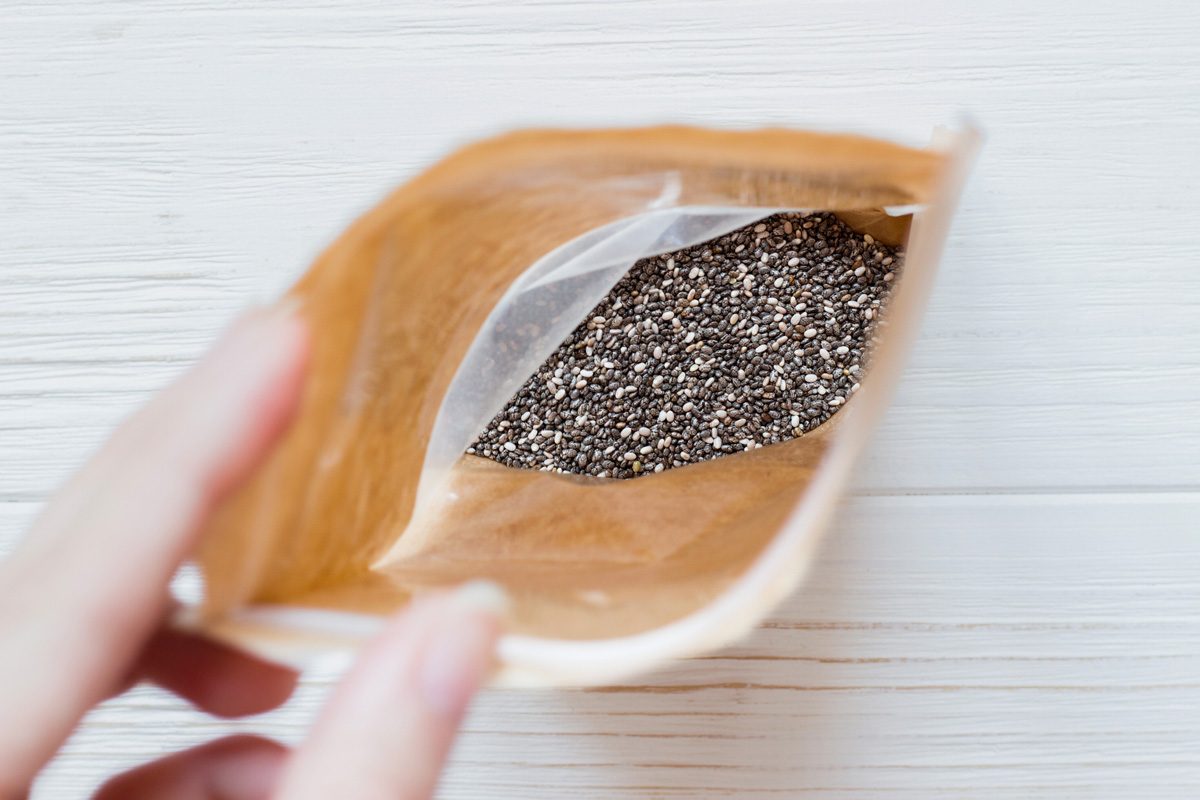
15 Natural Appetite Suppressants That Really Work, According to Nutrition and Hormone Experts

About the experts
|
Highlights
|
Struggling with cravings or a ravenous appetite is frustrating, and can sabotage even the best-intentioned health goals. But experts say medication isn’t necessarily the answer—you can load up your diet (and lifestyle) with natural appetite suppressants to help curb cravings and feel fuller throughout the day. That’s because there’s a difference between hunger and appetite, and our diet and lifestyle can influence these sensations.
“Hunger is a physiological desire to eat, driven by changes in hormones when the stomach is empty,” explains Lona Sandon, PhD, RDN, LD, an associate professor of Clinical Nutrition at UT Southwestern. “Appetite is typically defined as a hedonic desire to eat. You may not actually be hungry, but you desire to eat because of how food looks, smells, or simply because it is in reach.”
Eating to fulfill your appetite isn’t related to metabolic necessity or fueling for energy, adds Richard Siegel, MD, an endocrinologist and Co-Director of the Diabetes and Lipid Center at Tufts Medical Center. That’s why appetite suppression isn’t about starving yourself.
Our experts explain how certain foods and other natural appetite suppressants can help regulate your hunger hormones, keeping you feeling satisfied without deprivation.
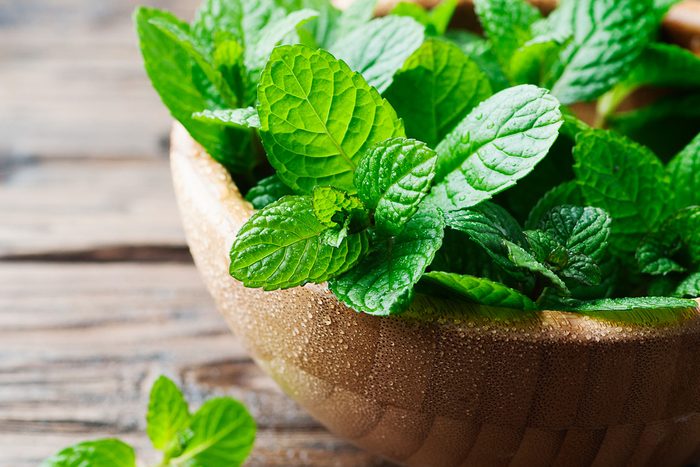
What causes increased hunger or cravings?
Hunger is primarily controlled by hormones in our body, says Dr. Siegel. Ghrelin, or “the hunger hormone,” gets produced in the stomach and signals to our brain that it’s time to eat.
As we eat, Dr. Siegel says that digestive hormones get released in our small intestines, including GLP-1 (glucagon-like peptide-1), CCK (cholecystokinin), and PYY (peptide YY). These each play a role in helping our body digest food—but they also let our brain know when we’re getting full.
There are many dietary and lifestyle factors that can disrupt how well these hormones work, increasing our sense of appetite. These include:
- Poor sleep: Sleep deprivation may increase the release of ghrelin—which makes us feel hungrier—while reducing the levels of leptin in our body, Dr. Siegel says. “Leptin helps modulate feelings of fullness and when to store fat,” explains McCall McPherson, PA-C, a lead physician associate and founder of Modern Thyroid Clinic and Modern Weight Loss.
- Stress: Stress releases the hormone cortisol in the body, which can increase our ghrelin levels—contributing to our desire for high-calorie foods—and reduce the effectiveness of the satiety hormones produced by our gut, per 2025 research published in Lifespan Development and Mental Health.
- Highly processed, low-fiber diets: “Consuming processed foods and foods high in sugar tend to stimulate appetite and lead to cravings for those foods,” explains Julia Zumpano, RD, LD, a registered dietitian with the Cleveland Clinic Center for Human Nutrition. These foods are also typically low in fiber—and fiber is associated with a release of our satiety hormones, Dr. Siegel says. Because highly processed foods often have low nutritional value, they may also interfere with how well our hunger and satiety hormones function, according to 2024 research published in Current Nutrition Reports.
- Blood sugar imbalances: Highly processed foods have another knock-on effect. Since they often have little nutritional value, our body digests them quickly. This can make our blood sugar spike—and once the spike crashes, it can set off your appetite again.
- Dehydration: “Ensuring that you are well hydrated and meeting your fluid needs can aid in appetite suppression,” Zumpano says. “Some people may mistake being hungry for being thirsty.”
- Hormonal fluctuations: There’s a strong relationship between female sex hormones and appetite, according to 2022 research published in Frontiers in Endocrinology. During the luteal phase of a woman’s menstrual cycle—the part right before you get your period—estrogen levels drop slightly while progesterone levels rise. Estrogen is known to help regulate appetite, while progesterone can increase appetite and cravings. That’s why it’s pretty normal to feel hungrier than usual before your period.
- Medications: Some medications can impair how our body’s hunger hormones naturally function as well, Dr. Siegel says. These can include psychiatric medications (such as antidepressants or antipsychotics), glucocorticoids, and hormonal contraceptives (particularly progestin-only birth control).
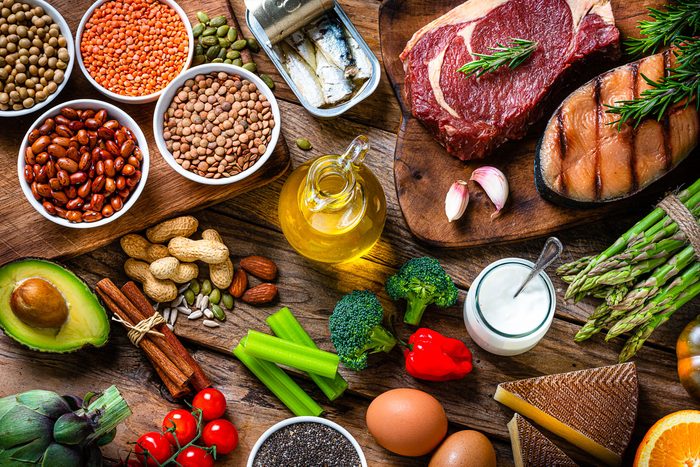
15 Natural appetite suppressants that actually work
“Fat, fiber, and protein help us feel full,” Dr. Sandon says. “All take longer to digest, stay in the stomach longer, and can affect the way hormones regulate hunger response.”
Specifically:
- Fiber slows down the emptying of the stomach and promotes the secretion of satiety hormones, Dr. Siegel says.
- Protein regulates hormones and keeps you feeling satisfied, according to Zumpano.
- Healthy fats slow down digestion and increase feelings of fullness. “Fat seals the deal in a meal,” Zumpano says.
Below, our experts point to their favorite hunger-controlling foods and other natural appetite suppressants that may have particularly strong effects.
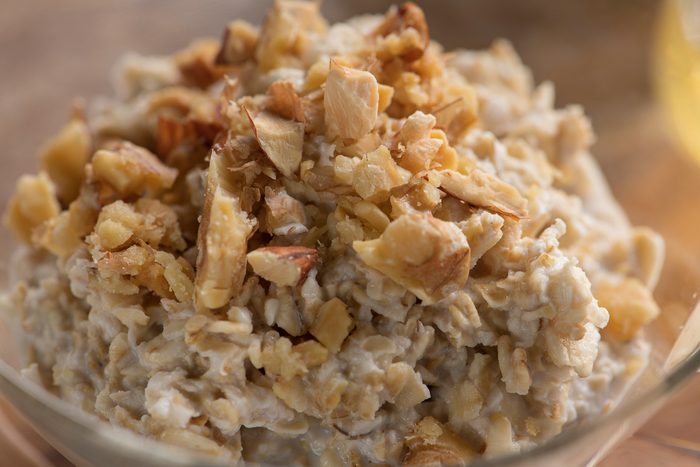
1. Oatmeal with walnuts
Oatmeal with walnuts pairs high-quality fiber with healthy fats, Dr. Sandon says. Walnuts also contain about 5 grams of protein per 1/4 cup.
If you’re not a fan of walnuts, “almonds are a good source of healthy fats, fiber, and protein all in one small snack,” says Kristine Dilley, RDN, CSOWN, LD, a registered dietitian nutritionist at The Ohio State University Wexner Medical Center.
Just make sure to choose minimally processed oats—such as steel-cut or rolled oats. This means the oats retain more of their natural, whole-grain fiber content.
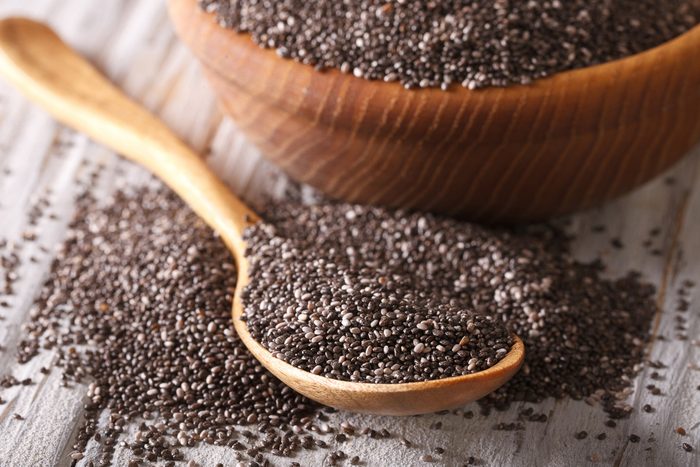
2. Chia seeds
Chia seeds are one of the highest plant-based sources of fiber, with about 5 grams in just one tablespoon. Much of this fiber content is soluble fiber, which absorbs water and physically expands in your stomach—so you feel fuller faster.
Still, chia seeds bring other appetite-busters to the table, including around 2.5 grams of protein and 2.5 grams of omega-3 fats (healthy fats many of us don’t get enough of).
Try adding chia seeds to your oats and smoothies or mix them into pancake batter and other baked goods. Or, try out one of these decadent chia pudding recipes for a healthy, filling dessert any time of the day.
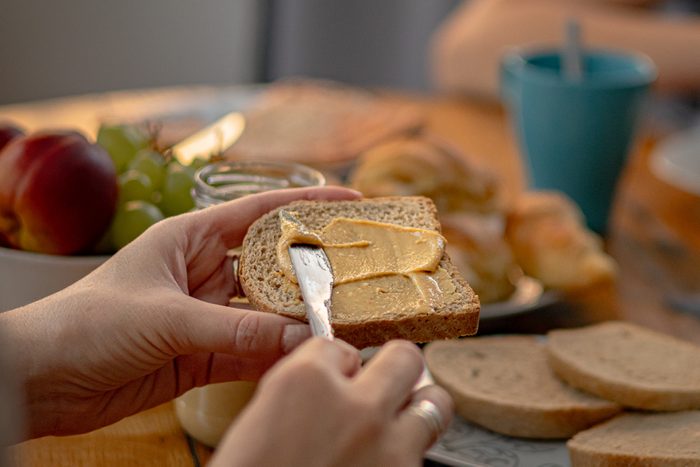
3. Nut butter or avocado on whole-grain bread
“You are never too old for a peanut butter sandwich or peanut butter toast,” Dr. Sandon says. She recommends 100% whole grain bread for its high fiber content and a drizzle of your favorite nut butter for healthy fat and protein.
“If you like something more trendy or grown up, try avocado—high fiber, healthy fats—on 100% whole grain toast or crackers.”

4. Cottage cheese with fruit
“Cottage cheese includes a protein called casein, which is sometimes referred to as a slow protein,” Dr. Sandon says. “It takes longer than other proteins such as whey to digest.”
Dilley advises that you top your cottage cheese with fruits. “Foods with a high-water content [like fruit] add bulk to your meals with less calories,” she explains. “This bulk creates a sense of fullness when the stomach stretches in response to a larger volume of food.”
Most fruits are naturally hydrating, but some stand-outs include strawberries, cantaloupe, pineapple, peaches, grapefruit, blueberries, mango, apples, and raspberries—all of which pair deliciously with cottage cheese. These fruits also have a high fiber content. “This leads to a slower emptying of the stomach contents, which keeps you feeling full for longer between meals and helps manage hunger,” says Dilley.
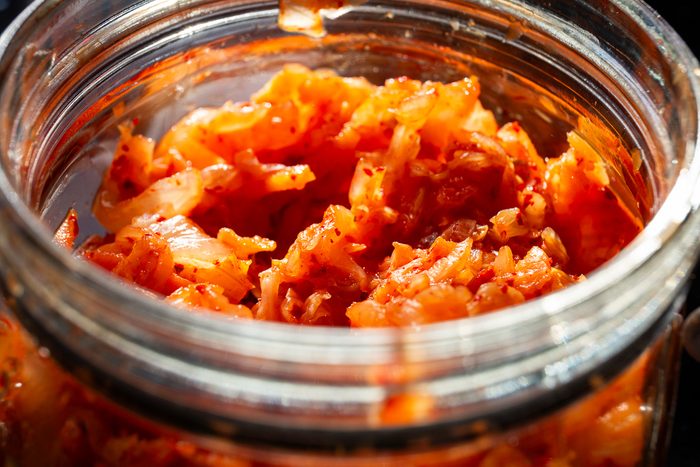
5. Resistant starch like kimchi or sauerkraut
Resistant starch is a type of starch—a carbohydrate—that is not digested in the small intestine. Instead, it moves further along the gastrointestinal (GI) tract, fermenting in the colon. This process potentially has beneficial effects on intestinal health, blood sugar balance, metabolism, and more, according to a 2022 review of research published in the Journal of Functional Foods.
McPherson says that resistant starch foods include:
- Kimchi
- Kefir
- Sauerkraut
- Green bananas
- Potatoes
- Legumes
“These naturally stimulate your body’s own GLP-1 production [one of our gut’s satiety hormones], enhance insulin sensitivity, curb cravings, and can also even reduce cholesterol and encourage weight loss,” she says.
McPherson recommends pairing resistant starch foods with healthy fats for optimal nutrient absorption.

6. Plant protein like tofu or nuts
“Studies have shown that lean protein consumption can suppress appetite through decreasing ghrelin—the hormone that stimulates hunger,” Dilley says. “A diet that is higher in protein and very low in carbohydrates may increase ketone production, which can also inhibit appetite directly in the brain,” Dr. Siegel adds.
Lean, high-protein foods can include lean meats like chicken or fish, Greek yogurt, eggs, and soy products, Dilley says. Tofu, seitan, and tempeh are great sources of plant-based protein, adds Zumpano.
However, Dr. Siegel points to specific plant proteins for their dual benefit. “Unprocessed plant proteins such as legumes, nuts, and seeds combine fiber and protein together,” he says. “These should be spread over the day to optimize energy for the body.”
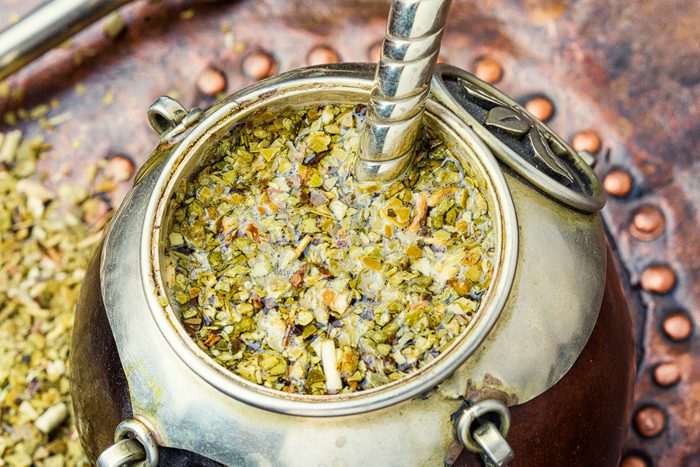
7. Yerba mate tea
“Yerba mate tea has been shown in studies to have an appetite-suppressing effect related to increased expression of GLP-1 and delayed gastric emptying,” Dilley says. “Participants also subjectively reported increased satiety (fullness), reduced hunger, and improved mood.”
McPherson agrees. “I began really enjoying yerba mate about 10 years ago,” she says. “I certainly experience an appetite-suppressive effect, but I also truly enjoy the type of caffeine response I experience when drinking it. It certainly helps with focus and concentration.”
She says that yerba mate contains compounds like catechins, caffeine, and theobromine that modestly boost GLP-1 secretion, improve insulin sensitivity, and reduce appetite and cravings.
For the best absorption of yerba mate’s compounds, McPherson advises adding lemon and to avoid drinking it with iron-rich meals. “[Have it] between meals, especially late morning or mid-afternoon.”
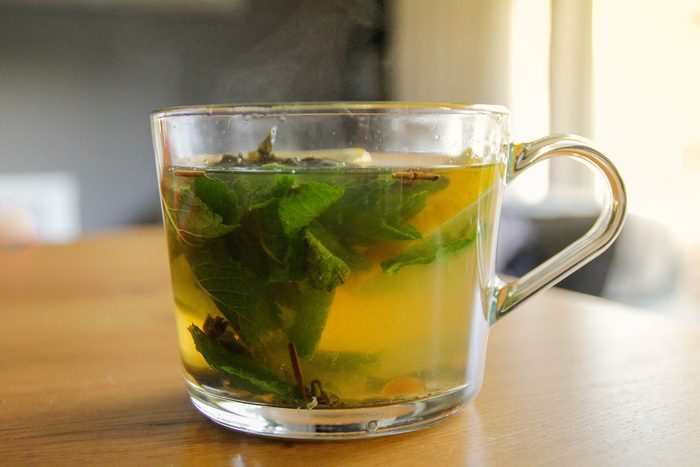
8. Green tea
Similar to yerba mate, “green tea contains catechins that can help regulate the hunger hormones, leptin, and ghrelin,” Dilley says. “It also contains caffeine, which can have an appetite-suppressing effect for some individuals by encouraging alertness and activity.”
Green tea also contains L-theanine, which can help you relax and focus.
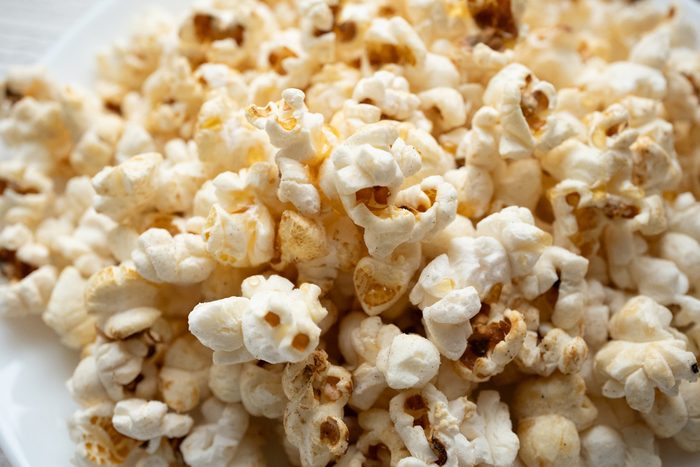
9. Popcorn
“Popcorn is a whole grain that provides fiber,” Dilley says. But avoid the microwavable bags—these products may contain artificial flavorings, unhealthy oils, high sodium levels, or other additives.
“Use the air-popper and avoid adding high-calorie oils and butter to get a low-calorie snack that will keep you feeling full,” she says. Then, flavor with spices of your choice. (Here are some flavored popcorn ideas from our sister site Taste of Home.)

10. Dark chocolate
Need more inspiration for your popcorn topping? Try a drizzle of dark chocolate, Dilley suggests. “Dark chocolate has been shown to increase satiety and decrease cravings due to the high fat content coming from cocoa butter and a higher protein content compared to milk chocolate.”
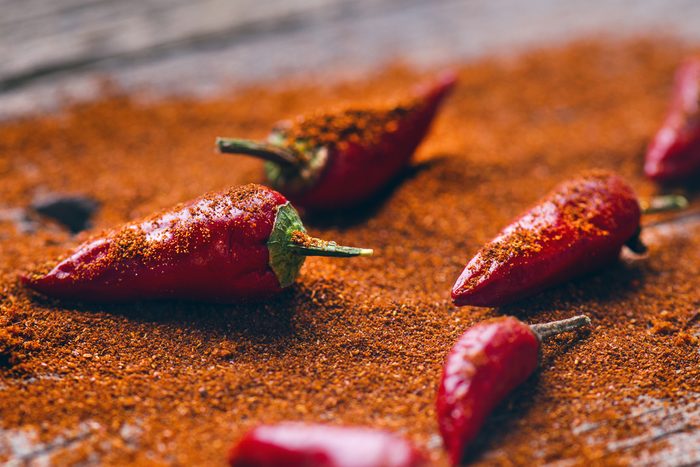
11. Chili peppers
Capsaicin—the compound found in chili peppers that makes them hot and spicy—has been associated with increased satiety and increased energy after consumption, Dilley says.
Past research published in the European Journal of Nutrition found that capsaicin increases GLP-1 levels and decreases ghrelin levels, reducing appetite. A 2024 study published in the Journal of Jiroft University of Medical Sciences backs these findings up.

12. Legume pasta
“Most Americans are not consuming enough fiber,” Zumpano says. And, as Dr. Siegel emphasizes, fiber-rich foods may be the most effective in helping with feeling full. The goal is to spread out 25 to 40 grams of fiber throughout the day, Zumpano adds.
One simple swap she recommends is trading white pasta for legume or bean-based pasta. She says this higher fiber content expands in your stomach and allows for an earlier—and longer—satiety.

13. Fluids
Increasing your fluid intake between meals can help control your appetite, Zumpano says. According to the Cleveland Clinic, our body’s hunger hormone—ghrelin—may decrease when we’re hydrated and increase when we’re dehydrated. That’s one theory behind why we often think we’re hungry when we’re actually thirsty.
“Keep water with you, sip on herbal teas or sparkling water throughout the day, and add a glass of water 10 to 15 minutes before meals to take the edge off your hunger prior to eating,” Dilley advises.
Still, you don’t have to only drink water for hydration. Zumpano says tea, sugar-free electrolyte drinks, 100% vegetable juices, celery, cucumbers, soup, broth, and lettuce are all great fluid sources to stay hydrated.

14. Coffee
Not only can coffee contribute toward your daily hydration goals, but its caffeine content may increase metabolism and have a mild appetite-suppressive effect, Zumpano says.
A 2024 article published in Scientific American adds that coffee contains chlorogenic acid, a plant-based antioxidant that’s thought to help regulate blood sugar levels—which can influence our appetite. The bitter taste of coffee may also trigger our gut’s appetite-suppressing hormones.
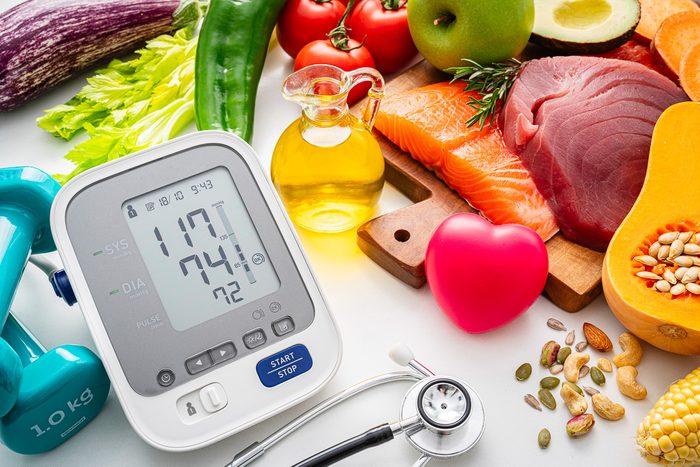
15. The DASH or Mediterranean diet
Our experts emphasize that it’s unlikely one natural appetite suppressant will curb your cravings for good. “Pairing all of these food components together will lead to the best outcome,” Zumpano says. “A balance of lean protein, fiber, healthy fat, and adequate fluid at meals.”
That’s why Dr. Siegel recommends the Mediterranean and DASH (Dietary Approaches to Stop Hypertension) diets. Both diets offer flexible, balanced eating plans that have been shown to improve health and are naturally high in these appetite-suppressing components: fiber, healthy fat, and protein.

More tips on how to reduce your appetite
“I often encourage my patients to eat in a method of ‘ordering their food’—and I don’t mean takeout,” McPherson says. This is a method of eating where:
- Each meal starts with a protein.
- You follow up with a nutrient-rich fiber, such as green, leafy vegetables.
- Then, wait about 10 minutes before eating anything containing carbs or sugar.
“This not only facilitates less cravings by sending signals of fullness, but also contributes to lower and slower blood sugar and insulin spikes.”
Dilley offers a similar meal-planning approach. “Try adding a broth-based vegetable soup, a salad, or other raw vegetables at the beginning of your meals to add that bulk prior to eating the higher calorie part of your meal,” she says. “This will start to send satiety signals to your brain sooner, allowing you to feel full without overeating and still enjoy smaller amounts of the higher calorie foods in your meals.”
Dilley also recommends:
- Mindful eating: “Practice mindful eating by avoiding distractions,” Dilley says. “Eating slowly leads to better digestion and feeling full with smaller portions and fewer calories.”
- Stress management: “Incorporate daily stress management tools into your routine such as journaling, deep breathing, or quick meditations,” Dilley says. “Stress hormones can affect appetite and lead to excess calorie consumption.”
- Prioritize sleep: “Sleep consistent hours, at least 7 hours per night,” she says. “Sleep deprivation can increase hunger hormones leading to increased snacking.”
- Physical activity: “Get physical movement all throughout your day,” she says. “ Light activity such as walking can help manage hunger.”
For some people, time-restricted eating can aid in appetite suppression, Zumpano adds. “For those who are interested in intermittent fasting, I suggest trying to meet all nutritional needs over 8 hours front-loaded during the day as possible (such as between 8 a.m. and 4 p.m.),” Dr. Siegel recommends.

Avoid these things if you want to better manage your appetite
Certain dietary and lifestyle habits can contribute to greater hunger levels. Zumpano reminds us of a major one: Highly processed foods and foods high in sugar tend to trigger a sky-high appetite.
“They also can lead to overconsumption of these foods because they are ‘hyper-palatable,’” she says. That means the combination of yummy (but low-nutrient) ingredients activate our brain’s reward system, making us feel good—so we want to eat more.
Dr. Sandon also suggests to avoid:
- Skipping meals and allowing yourself to get too hungry.
- High added sugar, low-nutrition meals, such as donuts and coffee. “This will not leave you feeling full for long.”
- The “all or nothing” mentality. “Instead, make healthy eating a lifestyle,” she says. “Remember, healthy eating includes allowing yourself a treat once in a while.”
- The “I don’t eat anything with sugar“ mentality. “Fruit has natural sugars in amounts much lower than cookies, cakes, soda, and other sweet foods,” she explains. “Fruits also come with essential vitamins and fiber.”
- Combinations of unhealthy fats and salt, salt and sugar, fat and sugar, or the combination of all three.

When to see a doctor for your appetite
“A signal of a potential problem is when you find yourself binging on large amounts of food several times per week then purging or restricting in guilt about your behavior,” Dr. Sandon says. “Another is when [appetite control] becomes a social problem, and you find yourself not eating with others or secretly.”
She also says that it’s time to see a medical professional if difficulties with managing your appetite begin affecting your weight and health, potentially increasing risk factors for chronic conditions like obesity, type 2 diabetes, and heart disease. “Seek the help of a registered dietitian nutritionist,” she advises. “Ask your primary healthcare provider for a referral or contact your insurance provider for a registered dietitian nutritionist covered in your plan.”
A registered dietician nutritionist can help you form small habits that make healthy, satiating eating a lifestyle over time. Or, if your high appetite doesn’t change in spite of interventions—it could signal an underlying medical condition at play.
“If there is poor satiety from a very young age, this may be related to several genetic disorders that affect the appetite pathways in the hypothalamus,” Dr. Siegel says. “Insatiable appetite that starts as an adult may be related to disease in the hypothalamus (rarely), medication including many psychiatric medications as well as glucocorticoids, endogenous Cushing’s syndrome (where the adrenal glands make excessive cortisol), and primary mood disorders.”
Thyroid issues, PCOS, and type 2 diabetes are also known to affect appetite for some people.
In addition, Dr. Siegel notes that any significant change in hunger or appetite—whether it’s increased or decreased—should be evaluated by a medical professional.
For daily wellness updates, subscribe to The Healthy by Reader’s Digest newsletter and follow The Healthy on Facebook and Instagram. Keep reading:




















